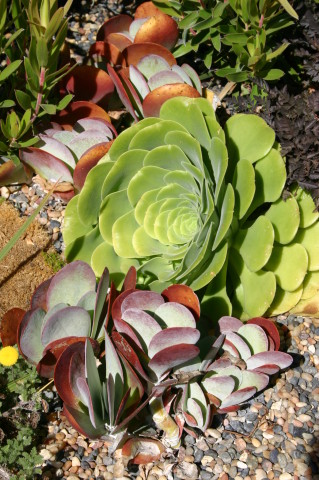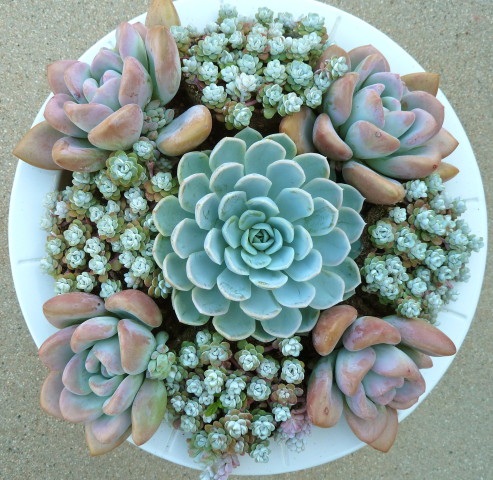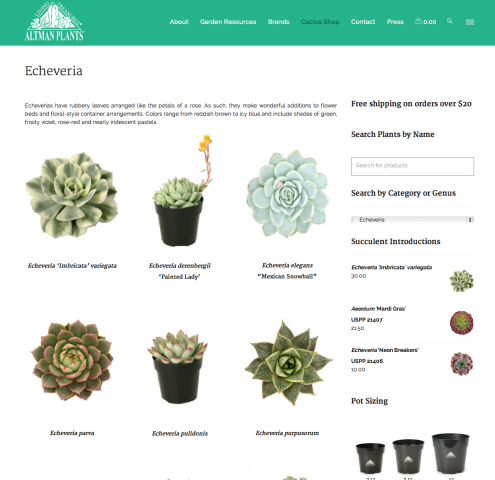
When Designing with Succulents came out in 2007, I proudly showed it to my son, to whom the book is dedicated. He said all the right things…nice layout, great photos…and then casually asked, “But why so many Latin names? Why not use the plants’ common names? They’re a lot easier to remember.” Well for one thing, Timber Press required Latin names because common ones are often inexact. But he had a point. Why not make the topic as easy and approachable as possible?
I was reminded of this recently when a friend asked why there’s no Succulents for Dummies book. I replied, “Well, I did write Succulents Simplified.”
He persisted. “It needs to be even more basic than that—a book for people who think succulents are cool, but don’t know anything about gardening, and are concerned they’re going to kill them.”
That got me thinking. What are the rock-bottom basics that people absolutely have to know to grow succulents successfully? I think I can sum them up in a few paragraphs:
What is a succulent? I adore nurseryman Jeff Moore’s definition: “any plant that, when stepped on, leaves a wet spot.” Unlike other plants that quickly wither if the soil goes dry, succulents are canteens. They store water to live on when there’s no moisture available. Not surprisingly, succulents come from parts of the world where it may not rain for months on end. During such dry spells, their roots may desiccate and disappear. The plant sits and waits like a well-sealed water balloon. Its leaves may shrivel and growth may cease, but when rain soaks the soil—or you come home from vacation—new roots form and leaves fatten.
So, how much water, and when? The biggest mistake people make with succulents is overwatering them. Waterlogged roots rot, the stem becomes squishy, and leaves fall off. However, succulents do require regular water to look their best. When they’re actively growing—which for most kinds is spring and summer—drench the soil once a week. When they’re dormant—usually in fall and winter—do so once a month. Fat succulents, like cactus, need less water than thinner ones like jade. When in doubt, don’t water. And don’t worry about this too much. These are not fussy plants. (There are exceptions. I don’t recommend trying to grow living stones right off the bat.)
What kind of soil? In the garden, to ensure adequate drainage, plant succulents atop mounded soil or on a slope. In containers, use commercially bagged “cactus mix.”
How about temperature? Succulents like fresh air, balmy temps, low humidity, morning sun and afternoon shade. Spiny and spiky succulents from the Americas, such as cacti and agaves, are better able to tolerate freezing temperatures (into the 20s F), all-day sun and high heat (above 90 degrees F) than smooth-leaved succulents such as aloes, aeoniums and kalanchoes (which are Old World plants from South Africa, Madagascar and the Canary Islands).

Fertilizer? Succulents don’t really need it, but it does help them grow faster and more lush. Dilute a balanced liquid fertilizer half-and-half with water and apply it once or twice in spring.
Why so popular? Not only are succulents easy to grow, their shapes are geometric, many are living sculptures, their leaves come in every color, and they range from dainty ground covers to thick-limbed trees. The variety is astonishing, with new ones continually being introduced.

Speaking of which, now available to the succulent-loving public is a new and noteworthy online shop. The largest grower of cacti and succulents in the US, Altman Plants, recently launched a retail, mail-order division that offers hundreds of varieties in any quantity and no minimum. “We’re very excited to have the mail-order site operating,” owner Ken Altman told me. “We have many new plants in production, about to hit the pipeline. This is a way to let people who will appreciate them access them.” Personally, I’m thrilled, because many of the plants shown in my books and videos originated in Altman greenhouses or growing grounds. The prices are excellent, too, with free shipping for orders over $20.

